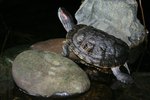
With more than 30 different seahorse species of varying sizes, temperaments and care requirements, research the types available and their specific needs before acquiring these aquatic critters. Also, know going in that there are limited options for combining seahorses with different fish, invertebrates, coral and other marine life. Because of the particular and relatively inflexible needs of seahorses, purchase a new aquarium with these needs in mind rather than try to convert a tank and risk stressing your seahorses with too little space or other unsuitable conditions.
Step 1
Choose a tall aquarium for seahorses, as they are vertically oriented and like to vary their depth. Get a tank that's at least 18 inches tall -- but preferably taller -- for average seahorses ranging from 5 to 8 inches long. For three to four seahorses with no other fish, an aquarium that's 20 inches wide, 20 inches deep and 24 inches tall is a good minimum size.
Step 2
Select a tank with a standard fluorescent strip light. Seahorses don't like much light, preferring less than a normal reef tank is equipped with; this is a primary reason it's generally inadvisable to pair seahorses with coral.
Step 3
Choose a high-quality tank filter that doesn't cause significant current or create bubbles. Seahorses are weak swimmers that don't move around or feed well in water with much flow. Opt for a filter rated for a larger aquarium than the one you're using; seahorses pass considerable amounts of undigested food that must be efficiently removed from the environment.
Step 4
Install a protein skimmer in your seahorse tank. It helps keep the water clean and adequately oxygenates the environment for your seahorses' weak gills.
Step 5
Follow the instructions on your salt mix to achieve salt water with a gravity between 1.021 and 1.024, which is the norm for marine aquariums.
Step 6
Maintain a water temperature between 74 and 76 degrees Fahrenheit. Use a tank fan over the water or a water chiller as necessary. This is cooler than many other marine lifeforms prefer, which is another complication in finding suitable seahorse tankmates. Keep a thermometer in the aquarium to monitor the water temperature.
Step 7
Add substrate to the bottom of the aquarium. Live rock that's been cured to eliminate potential tank pests is a good option, as is sand. Choose substrate that's free of sharp or jagged edges, which can easily wound seahorses.
Step 8
Erect multiple "hitching posts" in the aquarium substrate; seahorses need structures to wrap their tails around. Fake coral, fake kelp, plants, slender rock formations and other suitably shaped items work well.
Step 9
Include a few snails, limpets or small hermit crabs in your seahorse tank. They serve as a beneficial cleanup crew for the food particles your seahorses leave behind.
References
Tips
- Remember to test your water chemistry regularly after tank setup. The water's pH should be between 8.0 and 8.3, ammonia and nitrite levels should be 0 and nitrate levels should be less than 20 ppm.
Warnings
- Shrimp, anemones, most crustaceans and quick or highly active fish should not share a tank with seahorses.
Photo Credits
-
Comstock Images/Comstock/Getty Images
Writer Bio
Eric Mohrman has been a freelance writer since 2007, focusing on travel, food and lifestyle stories. His creative writing is also widely published. He lives in Orlando, Florida.



